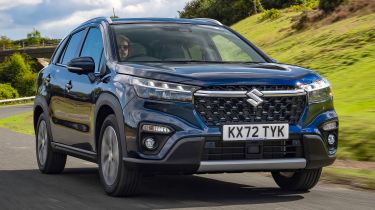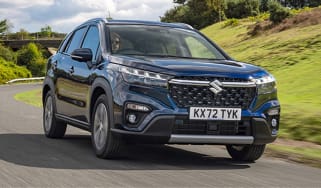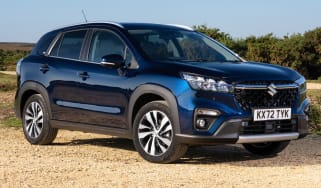Suzuki S-Cross review
The Suzuki S-Cross offers a lot for the money, but its utilitarian interior and unrefined hybrid system let it down

It's incredible that despite the Suzuki S-Cross having been around since 2013 it remains competitive with far newer rivals. Continual updates have yielded not one, but two hybrid systems that compete well ‘on paper’ with other compact SUVs for efficiency, while plenty of standard tech helps keep it competitive on price. The downside is that its dated interior shows the S-Cross up against fresher competitors, plus refinement could be better.
Our choice: Suzuki S-Cross Motion Mild Hybrid
About the Suzuki S-Cross
As we’ve already mentioned, the Suzuki S-Cross arrived in 2013. It was known as the Suzuki SX4 S-Cross at the time and came with a range of petrol and diesel engines. Since the latter fuel choice has fallen out of favour and several hybrid rivals have arrived, such as the Hyundai Tucson, Nissan Qashqai, Renault Austral and Toyota RAV4, the S-Cross is now offered with two petrol hybrid engine options.
The first is the mild-hybrid 1.4 Boosterjet 48v, putting the Suzuki up against other mild-hybrid rivals like the Mazda CX-5 and Peugeot 3008. The mild-hybrid system can’t drive under electric power alone; instead, it offers a little assistance to the engine when setting off or accelerating, helping to conserve fuel. It’s only available with a six-speed manual, but there’s a choice of two or four-wheel drive (called AllGrip) for extra traction.
The pricier 1.5-litre Hybrid S-Cross can also come with two- or four-wheel drive, but this time, you must have a six-speed automated manual. It’s the only way you can get an automatic S-Cross.
Used - available now

2025 Suzuki
S-Cross
10,828 milesAutomaticPetrol1.5L
Cash £16,042
2025 Suzuki
S-Cross
16,339 milesAutomaticPetrol1.5L
Cash £15,741
2025 Suzuki
S-Cross
33,724 milesManualPetrol1.4L
Cash £12,430
2025 Suzuki
S-Cross
27,790 milesManualPetrol1.4L
Cash £13,187There’s a choice of two trim levels: Motion and range-topping Ultra. The former has plenty of standard equipment and starts at just over £26,000, while the latter comes exclusively with AllGrip four-wheel drive.
This pricing puts the Suzuki in the realm of hybrid-powered small SUVs and undercuts a lot of family SUVs. However, the age of the S-Cross means it is small by contemporary family SUV standards and sits in between the two classes in terms of the interior space offered. Buyers wanting a larger SUV can step up to the Suzuki Across, a rebadged Toyota RAV4.
Engines, performance and drive
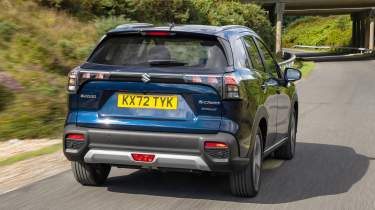
The Suzuki S-Cross is relatively light compared with its rivals (even the hybrid running gear only adds around 73kg to the car's kerb weight), and that helps it to feel fairly eager to change direction. However, its softer suspension set-up compared with the sharpest handling family SUVs (notably, the Ford Kuga and SEAT Ateca) means you’ll experience more body lean on twisty country B-roads. The other downside is that its light steering has little feedback, and the S-Cross doesn’t have as much grip as the Kuga, which robs you of some confidence in the car when pressing on.
The upside of its more compliant suspension is that the S-Cross will absorb impacts from speed bumps and potholes well in urban traffic and provide a calm ride at motorway speeds. You will have to crank the stereo up to overcome high road noise at speed, though.
As mentioned, you have a choice of two engines. Our preferred version is the cheapest engine in the lineup, the turbocharged 1.4-litre. It’s also the most powerful in the S-Cross range, with 127bhp. It does have mild-hybrid technology to provide a useful little boost in performance when setting off or accelerating, but you’ll need to rev it out to get up to motorway speeds swiftly. Its six-speed manual (the only gearbox available) is slick enough that this isn’t too much of a hassle.
On the other hand, the naturally aspirated 1.5-litre Hybrid is less powerful with 113bhp and comes exclusively with a frustrating six-speed automated manual. Such gearboxes have always been a bit of an acquired taste, and the one in the S-Cross is no different. It’s slow to react when you ask for more power to overtake and when setting off from a set of traffic lights. Its hesitation would, understandably, encourage you to press the throttle harder when you need to quickly make a gap when joining a busy roundabout, at which point the S-Cross lurches forward as the power comes in.
On the move, the gearbox provides slow shifts, and it feels as if the clutch is dragging with every change. You can attempt to overcome some of the gearbox foibles by selecting the car’s Sport mode to try and sharpen the responsiveness of the accelerator, or attempt to select gears yourself using the paddles behind the steering wheel, but considering that you don’t buy an automatic gearbox to change gears yourself, you’re better off sticking with the 1.4-litre. If you have to have an automatic, the Hyundai Tucson and Toyota RAV4 both have far smoother systems.
It’s a shame because the latter brand, Toyota, is Suzuki's technical partner, and the two have paired up to produce the Suzuki Across and Suzuki Swace, which are much more refined hybrid cars. The 1.5-litre engine in the S-Cross is always audible when running, while there are distinct whooshes and whines from the electrical part of the hybrid system when slowing down.
The 1.4-litre mild-hybrid and 1.5-litre Hybrid have regenerative braking to recoup energy for the battery pack. You can feel it working when you lift off the accelerator because it feels like a light amount of braking is being applied. It isn’t as strong as the e-Pedal regenerative braking of a Nissan Qashqai, but it can quickly recoup a decent amount of energy back into the battery.
The mild-hybrid system doesn’t have the gumption to move the car under electric power alone, and the 1.5-litre Hybrid isn’t much better. You’ll need to tread gently on the accelerator to keep the engine from firing up. Drive in such a way to keep up with the flow of traffic, and you’ll find the engine has to kick in within a few feet of setting off.
0-62mph acceleration and top speed
It takes the standard mild-hybrid S-Cross 9.5 seconds to get from 0-62mph, while the four-wheel drive version needs 10.2 seconds to complete the same benchmark sprint. The less powerful full-hybrid S-Cross takes 13.5 seconds to reach 62mph if get the 4x4 version, or 12.7 seconds if you stick with front-wheel drive. For context, the most basic Nissan Qashqai only needs 10.2 seconds to get up to 62mph, and the Tucson Hybrid will do 0-62mph in eight seconds exactly.
Top speed for the S-Cross Mild Hybrid stands at 108mph, with the full-hybrid versions capable of reaching 121mph
MPG, CO2 and Running Costs
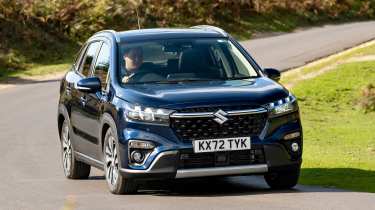
The 1.5 Hybrid in two-wheel drive form is the most efficient Suzuki S-Cross at 54.3mpg; the least is the 1.4 Boosterjet four-wheel drive at 47.8mpg. Our preferred 1.4 Boosterjet two-wheel drive is nearly as good as the hybrid, though, at 53.2mpg: that’s better than the hybrid Tucson. Neither comes close to the Renault Austral for fuel economy, though.
Nor can they beat the Austral for emissions. With just 105g/km versus 118g/km for the 1.5 Hybrid S-Cross, the latter will cost you more in Benefit-in-Kind (BIK) tax as a company car driver. If you want even lower BIK rates, you’ll need an electric family SUV like the BYD Atto 3 or Kia Niro EV.
Depreciation
Of the Suzuki S-Cross range, it’s the 1.4 Boosterjet in four-wheel drive AllGrip Ultra trim with the best resale values. Even then, it trails behind the rest of its compact SUV competition, particularly the Renault Austral and Toyota RAV4.
To get an accurate valuation on a specific model check out our valuation tool...
Interior design and technology
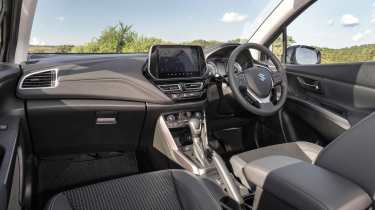
Fans of chunky buttons will probably like the interior design of the Suzuki S-Cross, but anyone coming to this from a Volkswagen Group car (or any of the Suzuki’s modern competitors) might dislike the cheap-feeling interior trim which dates the S-Cross.
On top of that, you can’t get a fully digital instrument cluster with the S-Cross like you can in many of its rivals, which means it doesn’t have the customisation of the virtual cockpit available in the Volkswagen Tiguan. Plus, the small screen displaying trip, fuel economy and hybrid power flow information is controlled by reaching awkwardly through the steering wheel spokes to push a small stalk in the cluster rather than via buttons in the steering wheel.
Sat-nav, stereo and infotainment
Entry-level Motion models use a smaller seven-inch central touchscreen, while the flagship Ultra model boasts a larger nine-inch infotainment system. The nine-inch system features sharper graphics and a slicker interface than the Suzuki systems of the past, and comes with sat-nav. However, the screens in the Hyundai Tucson and Kia Sportage are sharper still and easier to use with a more intuitive menu layout. You can bypass the Suzuki software completely by utilising the standard Apple CarPlay or Android Auto smartphone connectivity.
The system's sound quality is fine, but you need to turn it up quite a bit to counteract the engine and road noise, and you can’t option an upgraded sound system to provide a bit more punch, like the Bose sound system found in the Nissan Qashqai.
Practicality, comfort & boot space
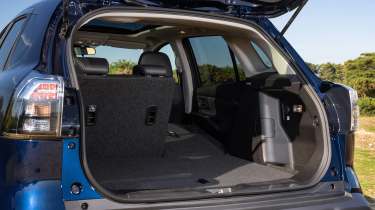
There’s plenty of room up front for a pair of six-footers, although the driver will have to adjust their seat manually because no version of S-Cross comes with electric adjustment or memory settings. There are a number of spaces to store small items, from the large door pockets to the decent sized glove box – although the rather chunky manual takes up a chunk of that space.
The S-Cross being smaller than many of its rivals, the driving position doesn’t have the commanding view you get in the Hyundai Tucson and Kia Sportage. Thin windscreen and roof pillars mean there’s a decent view out of the S-Cross, while Ultra versions come with a surround-view camera system to aid parking.
LED headlights do come as standard and provide brighter light than halogen alternatives. Automatic high beam assist isn’t available with the S-Cross, unlike its more modern rivals.
Size
The Suzuki S-Cross is 1,593mm tall, 4,300mm long, and 1,785mm wide. As we’ve already alluded to in the introduction, the age of the S-Cross makes it an outlier because newer family SUV rivals like the Nissan Qashqai and Kia Sportage have all grown in the interim, meaning the S-Cross – literally – comes up short.
Leg room, head room, & passenger space
Head backwards, and you’ll do well to avoid the range-topping Ultra, because its panoramic glass roof eats into the available headroom. It’ll be a squeeze to fit three adults across the back seats, and legroom is tight by class standards. Unfortunately, the S-Cross doesn’t have the clever sliding rear seat feature of the Renault Austral to increase knee room if you don’t need to put much in the boot. Like most of its rivals, the two outer rear seats have Isofix mounting points.
Boot
The standard boot size in the 1.4-litre car is 430-litres, but this shrinks to 293-litres with the 1.5-litre Hybrid because the battery pack lives below the boot floor and robs some capacity. The latter is particularly disappointing because there are small SUVs like the Renault Captur and Toyota Yaris Cross that offer more boot room – let alone the vast 620-litre boot offered by the Hyundai Tucson.
You can fold down the back seats in a 60/40 split and they lay flat, making it easier to load longer items. The 1.4-litre has an adjustable height boot floor with some underfloor storage, and with the floor in its raised position this removes an annoying lip you’d have to lift items over. The boot entrance is quite wide, plus the space is usefully square, making it easier to arrange items in the back.
Reliability and safety
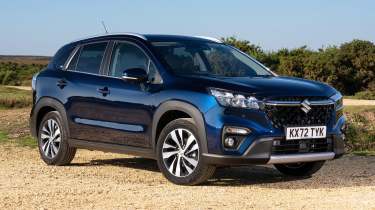
Do you remember how we mentioned in the beginning that this car dates back to 2013? That’s important because while it did gain a five-star Euro NCAP rating back then, that rating has expired. The old rating wouldn’t stand up to comparison with newer rivals, because they have all been tested under a more stringent regimes.
There are other drawbacks, too. The Suzuki S-Cross’s interior quality isn’t quite up to the standard of its Volkswagen Group competitors, and some of the trim feels cheap and looks outdated against the competition.
It should prove to be robust since only eight per cent of respondents to our Driver Power survey had any need to visit a Suzuki dealer with issues. Unfortunately, the brand did poorly in the aforementioned areas of build quality, refinement, and infotainment – all areas where the S-Cross could do with improvement.
Warranty
The standard Suzuki warranty period is three years or 60,000 miles, which isn’t anything special next to the five-year/100,000-mile policy of Hyundai, or the seven-year/100,000-mile scheme of Kia. However, you can extend the warranty by 12 months at a time through routine servicing at a franchised dealer, just like you can with a Toyota. So long as you keep servicing your car at a Suzuki dealer, you can keep your car under warranty up until the car is seven years old or has covered 100,000 miles.
Servicing
All versions of Suzuki S-Cross require servicing annually or every 12,500 miles. You can set up a three-year service plan for any Suzuki up to six years old, but it is calculated based on your individual mileage, so you’ll need to organise it yourself by using the contact information on Suzuki’s website.
Deals on the Suzuki S-Cross and alternatives
